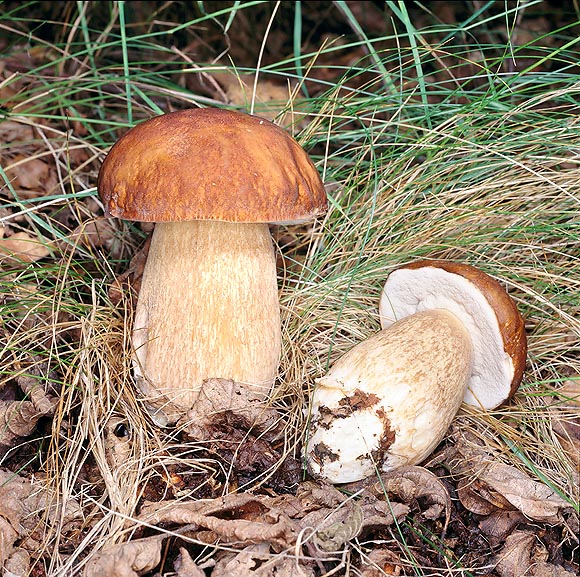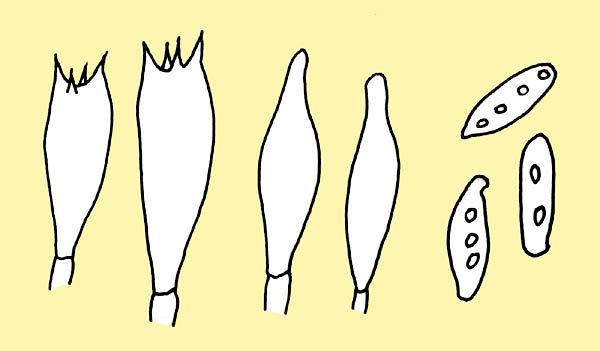
Text © Loredana Battisti

English translation by Mario Beltramini

The reticle covers all the stem. Frequent in summer. Choice edible also raw © Giuseppe Mazza
Family: Boletaceae Chevalier.
Subfamily: Boletoideae Singer.
Genus: Boletus Dillenius: Fries.
Section: Edules Fries.
Boletus aestivalis Paulet : Fries 1838.
The name comes from the Latin “aestivalis” = of the summer, as its growth takes place mostly in summer.
The genus Boletus is characterized by mushrooms with hymenophore (structure which contains the fertile part of the mushroom, the hymenium, where the reproduction of the spores takes place), formed by tubes and pores which can be easily loosened from the underlying flesh of the cap. The section Boletus usually gathers sturdy species, with persistently white flesh, stem with a net, the hymenophore shows a white colouring in the young specimen, yellow when ripe, and olive-green when aged (like the colour of the spore print).
Cap: of medium and big size, from 5-20 cm and more, fleshy, initially hemispheric then convex, finally, flat, dry cuticle, glabrous, finely velvety in the young specimen, it shows, at times, some cracks with dry weather; it has a brown-ochre, light brown, also with dark-brown tones.
Hymenophore: very small tubules, long, adnate-rounded, from white to yellow to olive-green with the ripening of the spores, easily loosening from the flesh of the cap, non staining at the cut, small pores concolorous to the tubules, non staining when touched.
Stem: 4-18 x 3-5 cm, fleshy and sturdy, from obese to barrel-shaped, rounded, bulbous, very variable, of light brown colour, in any case very pale, it shows a concolorous small net which extends all over the stem, so much that this characteristic confers it the name of Boletus reticulatus.
Flesh: white, compact, hard, tender when ripe and unchangeable. Fungous smell and taste.

Boletus aestivalis cystidia, basidia and spores © Pierluigi Angeli
Chemical reactions: negligible.
Spores: elliptic and spindle shaped, smooth, of 12,5-16 x 4-5 µm of size.
Habitat: In latifolious woods, mainly oaks, chestnuts, hazels, beeches, but also in conifer ones (firs and pine trees), typical thermophilic and xerophytic species, which loves warm and dry locations, much more infrequent in the north, more common in the Mediterranean and Apennines zones. The period for the growth goes from spring to early autumn.
Edibility: excellent; even raw, if consumed in small quantities.
Notes: easily identified species mainly for the small net which extends all over the stem.
Remarks: Very common mushroom and also much looked for, together with those of the same group known as “porcini”: Boletus aereus, Boletus edulis, Boletus pinophilus. It differentiates from the Boletus edulis both for the habitat, as this last prefers a cooler climate, and for a cuticle always rather viscous and a white small net on the stem and not much extended; at times it is difficult to distinguish it from the Boletus aereus when the Boletus aestivalis has darker tones on the cap; it differs from the Boletus pinophilus for a vinous-reddish colouring on the cap and concolorous net, typical characters of this last species. Furthermore, the most unpleasant error might occur with the Tylophilus felleus (Bitter boletus) which apparently, and mostly in young specimen, might be mistaken with the Boletus aestivalis; but caution! as this species has a very bitter taste: just only one small specimen is sufficient for rendering uneatable an otherwise excellent dish of ceps. It differentiates, however, for the colour of the pores, pink when ripe, and for a rough net on the stem.
→ For general notions about Fungi please click here.
→ To appreciate the biodiversity of MUSHROOMS please click here.
